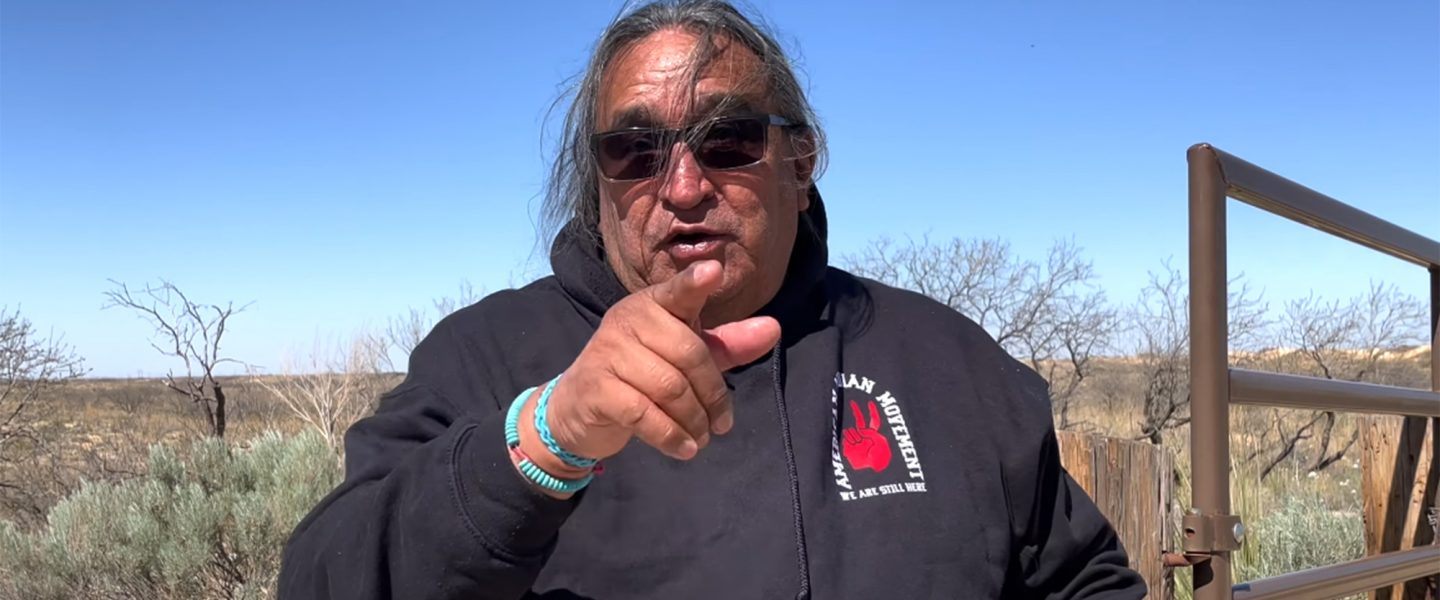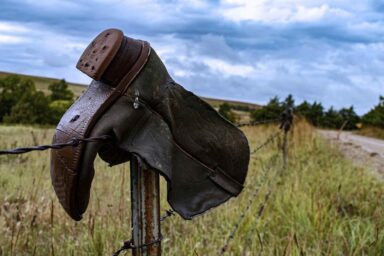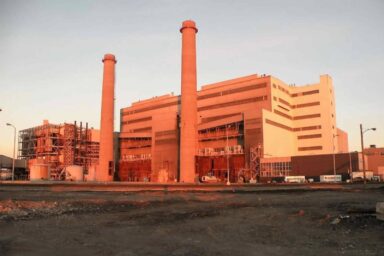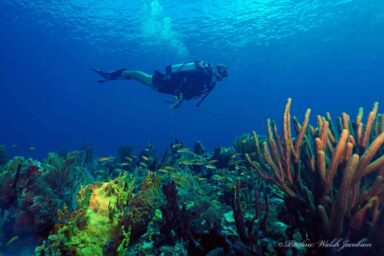Racist mascots. Fossil fuel extraction. Murdered and missing Indigenous women. Native runners highlight the high cost of continuing colonial domination in the United States.
|
Listen To This Story
|
This story by Greg Harman was originally published by Deceleration and is part of Covering Climate Now, a global journalism collaboration strengthening coverage of the climate story.
•
MONAHANS, Texas — On March 25, a small band of runners, shadowed by a few vehicles emblazoned with messages reading “Protect Our Water” and “Bridge to the Ancestors,” set forth from Monahans Sandhills State Park. Running relay style on the frontage road of Interstate 1-20, the mostly Lakota runners passed gas plants and fracking sand mines heading west toward Balmorhea Lake, a rare water feature in this high West Texas desert, and into the Big Bend. The route of Bridge to the Ancestors Youth Walk, organized by the Carrizo/Comecrudo Tribe of Texas, links into the flow of the Rio Grande/Rio Bravo and southward to the Gulf of Mexico. The effort is being used to highlight ongoing colonial violence targeting Native peoples across the borderlands of south Texas and northern Mexico and beyond.
“They took the silver, the gold, whatever they could,” Carrizo/Comecrudo Tribal Chair Juan Mancias said of early violence of Spanish explorers and would-be conquistadors. Then he quickly namechecked a handful of oil and gas companies, who he described as modern-day colonizers continuing and compounding legacies of genocidal violence.
“It’s not right for a few nerds that run [Energy Transfer Partners], and Exxon, and Next Decade to decide what’s better for us. Because they don’t know. Because all of the stuff that’s coming out of here is still going overseas, just like all the gold and the silver.”

The tapestry of anti-Indigenous crimes are discussed matter-of-factly along the run at frequent stops and engagements with community members and supporters as the caravan now moves with the river toward a concluding ceremony planned for Port Isabel, anticipated on April 2. Themes discussed on the event’s website also include the Indian Welfare Act, Indigenous sovereignty, and missing Native children of the historic boarding school system, as well as the epidemic of murdered Indigenous women. Native American women are targeted and killed at more than 10 times the national average and almost always at the hands of non-Native perpetrators. The violence against Native women also has been linked back to the fracking boom and transient worker camps.
Sitting before a low break of trees before the rolling dunes of the park following a short opening ceremony, Mancias described the culture clash between those wielding political power on behalf of multinational corporations and those striving to continue upholding what he described as the values of the first peoples of the land.
“To us it’s people first, profits later,” Macias said. “It should never be profits before people. That’s why we talk about things the way they are, that we are this land — not because we own it, but because it owns us. … For us ‘critical infrastructure’ is the water, the land, the air, and humanity. For them it’s all the construction, yeah? And that’s totally different.”
Others, like Carrizo/Comecrudo tribal member Christopher Basaldú, also described the poisoning of families and the planet by the exploitation of fossil fuels as a continuation of the earliest colonial efforts that so drastically came to transform the Americas. Referencing the Permian Basin, the heavily fracked landscape ranging across hundreds of miles of West Texas and southeastern New Mexico, which the nonprofit Earthworks recently highlighted as the global epicenter of accelerating climate destabilization, Balsaldú said:
“This is one of the centers of the Permian Basin that is right now extracting incredible amounts of oil and gas, and it’s literally toxic. It is literally poisoning our world. And climate scientists are saying that we don’t have any time left to get away from the burning of fossil fuels. But what are all the nations of the so-called civilized world doing? They are doubling down, tripling down, they are trying to expand our consumption of fossil fuels. That is a problem for the globe, but the people who are hurt the most are the poor people, people of global south, Black and brown people, Indigenous people.”

Following the opening ceremony while the group snapped pics minutes before the start of the run, a shooting star, as captured in the above video, was clearly seen falling behind the posted runners.
The fact of the escalating violence of official US and state policies, as well as racist militias collaborating to delay and deny migrants from exercising their internationally recognized right to seek asylum, was not lost either.
A group of Lakota youth came to Texas to support the effort.
“We are running in solidarity with the Carrizo/Comecrudo relatives here in Texas to help carry on the traditions, spirituality, and to protect their sacred sites,” Lakota runner Danny Grassrope explained. “We feel that it is very important that the Indigenous communities across Turtle Island stand together to continue to protect our ways of life.”
The group is highlighting the connection of all of this to the growing state violence militarizing the US-Mexico borderlands, historic homeland of the Carrizo/Comecrudo Tribe of Texas, or Esto’k Gna.
“The river connects us to our ancestors’ past, present, and future,” Basaldú said. “And it’s part of this colonial violence that has created it as a very violent militarized border. Because before colonization and before invasion, that river was not a boundary, it was a source of life, it’s what connected people.”
Lakota runner Jace Charger encouraged fellow runners to be cautious as they moved through the unfamiliar and vast network of oil and gas activity.
“We’re going to be breathing in some not-so-good air that we’re not used to,” Charger said during the opening ceremony at Monahans. “If you feel woozy, if it makes you feel sick, take a break. It’s not about your endurance. This is very toxic air that we’re going through. But this is air that our relatives breathe in every day. A week of this experience we’re going to live the lives of so many others and it’s a great opportunity.”
Charger also urged the group to remain in prayerful awareness — especially if faced with hostility.
“When people come at you in an angry way, meet it with prayer. Let them know how strong we are as a people. And how easy it is to let anger take over your heart but it takes a lot of courage to stand in the face of anger and bigotry and still meet it with prayer and kindness. And that’s what we’re trying to show today, the resiliency of our people.”
Follow the Bridge to the Ancestors journey with the Carrizo/Comecrudo Tribe of Texas and supporters at the tribe’s Instagram channel.








